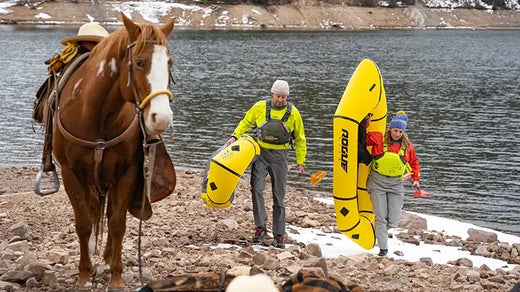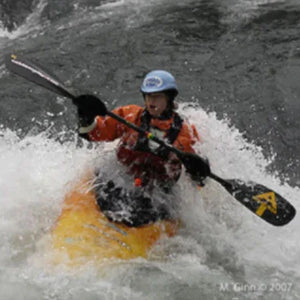Wetsuit vs Drysuit: Which Is Right For You?
January 11, 2022

When it comes to kayaking, standup paddle boarding, rafting, or any water activity, you need the proper attire. This isn't just to help you look the part—it's to help keep you safe and comfortable. Appropriate clothing can make or completely ruin your water adventures.
Two of the most common types of paddle clothing you'll hear about when it comes to staying warm and safe during those cold water days are either a kayak dry suit or a kayaking wetsuit. What is the difference between these, you ask? And which of these is right for your next outing? Understanding the garments and how they work is essential to which one is best for YOU.

Why Do You Need A Wetsuit or Drysuit?
The importance of wearing a wetsuit or drysuit when dealing with icy conditions must be stressed more. You may think, "I don't mind freezing water temperatures or the frigid, windy air outside! I can tough it out".
But this is not just about your comfort. This thermal protection protects you from cold temperatures, air, and water. Once the water temperature reaches a certain level, entering without protection becomes unsafe. A wetsuit or dry suit could save your life on the water! You must research the water entering and determine what you should wear. And be sure to factor in the air temperature and weather conditions! Now, let's look at some definitions to help you better understand the differences between wetsuits and drysuits.
What Is a Wetsuit?
Wetsuits are thin garments that athletes wear to provide thermal protection while wet. They’re typically made of neoprene or terraprene neoprene, and they offer thermal insulation by trapping a layer of water between your skin and the neoprene so that your body heat warms up. This enables you to safely paddle or swim in cold water & weather conditions without succumbing to hypothermia.
The garment is not breathable and is very snug to the body to maximize the heat layer. If submerged, you may feel a rush of cold water, but your body heat will warm that layer again. You’ll also notice that a wetsuit will make you a bit more buoyant, making floating or treading water more manageable, especially with your life jacket on, a must-have for kayakers & canoers. And it will add a bit of protection from bruising if you happen to find yourself floating down the river in rough waters.
We love the NRS Men's 3.0 Ultra John Wetsuit and NRS Women's 3.0 Ultra Jane Wetsuit. They have many stretches, are environmentally friendly, are made from high-quality Terraprene neoprene, you won't get any rub seams, are explicitly designed for paddling, and have a well-thought-out relief zipper for both men and women.
NRS Men's 3.0 Ultra John Wetsuit
NRS Women's 3.0 Ultra Jane Wetsuit
What is a Drysuit?
On the other hand, a drysuit is entirely waterproof and usually breathable, depending on the material. A drysuit is designed as an outerwear to seal out water from touching your body, but it's not necessarily designed to keep you warm. That’s where your layering pieces come in. You'll need to put layers of fleece or wool underneath the dry suit to provide warmth. Your warm underlayer can be one piece, like with a union suit or drysuit liner, or you can layer with a two (2) set of paddling tops and kayaking leggings. I like to wear a wicking layer of nylon or spandex against my skin underneath my fleece layers to move moisture away and allow the trapped steam and water vapor through the breathable membrane of the drysuit to keep from feeling damp and clammy as I’m paddling. Drysuits feature latex neck and wrist gaskets to keep 100% of the water out of your suit.
Check out our complete guide: What to Wear While Kayaking.
One of our top-selling drysuits is the Meridian Gore-tex Pro from Kokatat, widely considered the top drysuit standard. It's made with 3.21oz Evolution GORE-TEX® Pro Shell 3-layer fabric and Cordura® seat and knee reinforcement panels for supreme durability. It features an adjustable overskirt, GORE-TEX® socks, a relief zipper, a zippered chest pocket, latex gaskets, and neoprene punch-through over cuffs. Kokatat's limited lifetime warranty also covers it.
Kokatat Men's Meridian GORE-TEX Pro Dry Suit
Kokatat Women's Meridian GORE-TEX Pro Dry Suit
There is also a Semi-Dry Suit gasket with a neoprene punch-thru style neck gasket instead of the tight latex for a bit more comfort, but it could let in a tablespoon or two of water into the suit at the neck. As for fit, the Drysuit or Semi-Dry Suit will be looser than a Wetsuit, but no water will touch any part of your body covered by the suit.
OK, now that you know more about wetsuits and drysuits, which is right for you? Do you need both? Let us explain when we recommend you use each one.
Wetsuit vs Drysuit - When to Use Each One
While both wetsuits and drysuits will be necessary pieces of kayaking gear, the instances in which you would use each differ. There isn't necessarily a "winner" in the wetsuit vs drysuit debate. Instead, there are best practices you should follow in determining which one you will wear for specific conditions. Let's take a look.
When To Wear a Wetsuit
Those early morning paddles can get chilly as the weather changes from summer to fall. Or, on those unseasonably warm spring days when there’s a brisk breeze in the air, the water hasn’t warmed up enough for you to paddle in a bathing suit, and you just need something more on. These are perfect times and situations when a wetsuit will come in handy and give you added mobility as you paddle through the water.
If you are working on your Eskimo roll and practicing your rolls over and over, a wetsuit will be perfect to keep you comfortable on those days below 70 degrees, even with chilly water. You can even add a neoprene kayak hat to help cut down on those “ice cream headaches” during your roll practices. Remember, if it’s chilly enough for your light fleece jacket out of the water, it might be a great time to wear a wetsuit, neoprene skirt, or jacket and pants. However, that's not to say you don't also need a drysuit in your arsenal. Let's examine when you should wear a dry suit.
When to Wear a Dry Suit
If you're heading out for a day of paddling in icy conditions and need to keep the water from touching your skin, a dry suit will be your best bet. The beauty of a dry suit is that you can vary the layers you wear underneath to match the weather and water temperatures. You can layer up with warm-weather clothes underneath your dry suits, such as Union, bunny suit, pants, fleece, or wool tops, and don’t forget your paddling gloves.
Once you put on your dry suit, you'll enjoy the best of both worlds: warmth and dryness. The extra layers provide warmth, while the dry suit offers protection from the water itself. Whether you get splashed, work in a hole, or miss your roll and go for a swim, a dry suit will keep you comfortable and safe!
How to Pick Out Your Wetsuit or Drysuit
Whether you ultimately decide to get a wetsuit, drysuit, or both, there are some things you should keep in mind. These tips and tricks will help ensure you get the best possible fit and help keep you safe during your next paddle adventure.
When sizing your wetsuit, getting it as tight as possible is essential. A loose-fitting wetsuit won't provide the warmth you need, while one that is too tight might not be comfortable sitting in your kayak if you get what I mean. Not all bodies will fit in a standard 1-piece garment, so don’t forget that many paddling manufacturers will offer 2-piece options. If you've decided a wetsuit is best for you, we also recommend keeping your wetsuit fresh with wetsuit shampoo. It helps remove organic odor-causing bacteria, also known as "wetsuit funk," and neutralizes chlorine and salt deposits, preventing damage to the neoprene.
Now, for sizing your drysuit, it’s entirely the opposite! You want your dry suit loose enough to wear those fleece or wool layers underneath for warmth. We suggest adding 1 inch to your chest and waist measurements to give you room for those warm layers on your coldest paddling days. You also want to ensure you factor in your inseam to sit in a raft or kayak. Compressed layers or pinching fabric will not help keep you warm. Again, not all bodies fit in standard sizing, so know that it’s always better to have your dry suit a little loose than too tight. Dry suits can also be “burped” to force all the air trapped in the suit out, which helps the suit not feel so baggy. You can do this by putting on your dry or semi-dry suit, zipping the suit up, and pulling the neck gasket away from your skin ball, forcing all the extra air out. Then let go of the gasket and stand up!
While talking about gaskets, always open them with your hands and not force your head or hands through them. Latex gaskets are a bit fragile, which is why most dry suit manufacturers will not warranty them. And why do most outdoor stores sell drysuit replacement and repair kits? To be safe, we recommend that you don’t wear jewelry when putting on your dry suit to prevent rips or tears in your gasket. And be sure to keep your gaskets from drying out by regularly applying 303 Protectant to keep them supple.
Appropriate footwear is necessary, whether in a wetsuit or a dry suit. The right shoes will provide comfort, warmth, and protection from cold water during rowing, kayaking, SUP paddling, and similar watersports. For men, we recommend the NRS Men's Paddle Wetshoes.
For women, we recommend the NRS Women's Paddle Wetshoes.
If you have any questions about your new drysuit or wetsuit or need help with fit or usage, you can always consult the Outdoorplay team. We are available Monday through Friday, 8 a.m.—4 p.m. PST. Call us at 1-800-994-4327, and one of our friendly Customer Experience Representatives will gladly assist you.
Your choice to wear a wetsuit or drysuit for kayaking, standup paddle boarding, or another paddle sport will primarily depend on the type of activity and environmental conditions. You’re likely best suited with a wetsuit for milder temperatures in mild conditions. In contrast, a drysuit will entirely block out the cold air & water in colder conditions, assuming you’ve layered up properly.
Now you know everything you need to know to determine whether you should buy a wetsuit, dry suit, or both! One thing is left: head over to Outdoorplay and shop for all your kayaking, rafting, SUPing, and Kayak Fishing essentials!









